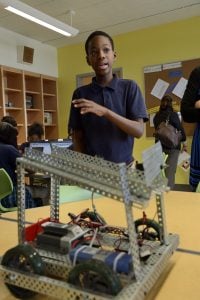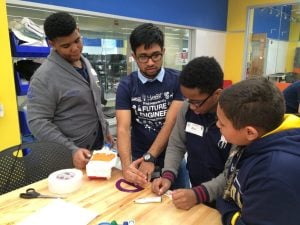The K-8 project-based science curriculum engages students in critical thinking, problem solving, and prototype development. Throughout the program, students work in collaborative teams to solve real world problems by using the engineering design process. By the time a student graduates from Barclay Elementary Middle School, they will have had 9 years of in-school engineering experience prior to beginning high school.
Curricula
SABES
STEM Achievement in Baltimore Elementary Schools (SABES) – designed collaboratively by Whiting School’s Center for Educational Outreach and Baltimore City Public School’s Office of Teaching and Learning - for grades K-5. The curriculum has been adopted by Baltimore City Public Schools. Learn MoreIQWST
Investigating & Questioning Our World Through Science & Technology (IQWST®) is a phenomenon-driven, 3-dimensional learning curriculum for grades 6-8 Learn MorePLTW
Project Lead the Way (PLTW), specifically Gateway to Technology, explores coding, robotics, flight, space, career landscapes and more for students in grades 6-8 Learn MoreCurricular Enrichments
Linking Barclay students to Baltimore’s rich STEM ecosystem and the Homewood campus.
 Barclay students participate in unit based, content aligned field studies where they experience real world application of science and engineering content.
Barclay students participate in unit based, content aligned field studies where they experience real world application of science and engineering content.
Some recent highlights include:
- K – 2 – Making for Young Innovators
- Futuremakers – Twice per year
- 2nd Grade – Role of Pollinators
- Cylburn Arboretum
- 5th Grade – Navigating by the Night Sky
- Banneker Planetarium
- 8th Grade – Optimizing a 3D-printed project
- JHU Makerspace
Previous Curricular Enrichments:
- 1st Grade – Day & Night Exploration
- Banneker Planetarium and Banneker Museum
- 3rd Grade – Animal Adaptations Exploration
- Carrie Murray Nature Center/AquaPartners
- 4th Grade – Wetlands Habitat Exploration
- Fort McHenry/Aquapartners
- 6th Grade – What Lives In the Harbor? Exploration
- National Aquarium of Baltimore
- 7th Grade – Engineering Cohort Experience
- Automation and Robotics at StarAcademy
 Students in grades 3-8 are invited to the JHU campus to experience both academic and student life. Faculty, staff, and graduate students from the Whiting School of Engineering and beyond, open their labs to Barclay classes for investigations, demonstrations, and engineering challenges align to content standards.
Students in grades 3-8 are invited to the JHU campus to experience both academic and student life. Faculty, staff, and graduate students from the Whiting School of Engineering and beyond, open their labs to Barclay classes for investigations, demonstrations, and engineering challenges align to content standards.
Campus visit themes include:
- 3rd Grade – Technology – Now & Then and HUSAM Applied Math Experience
- 4th Grade – Sound Science in the Natural World
- 5th Grade – Alternative Energy applications
- 6th Grade – Environmental and Civil Engineering
- 7th Grade – Mechanical Engineering and Robotics
- 8th Grade – Protein Modeling
“One thing I like? That we played together. One thing I learned? The sun can transmit energy and that is called solar energy. One thing I’d change? I would not like to change anything, because they received us well and I really liked the presentations! ”